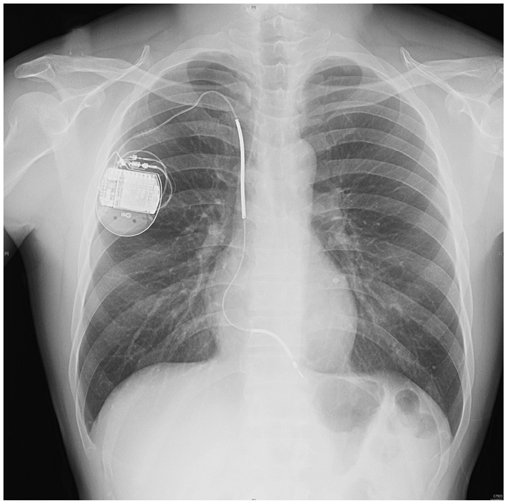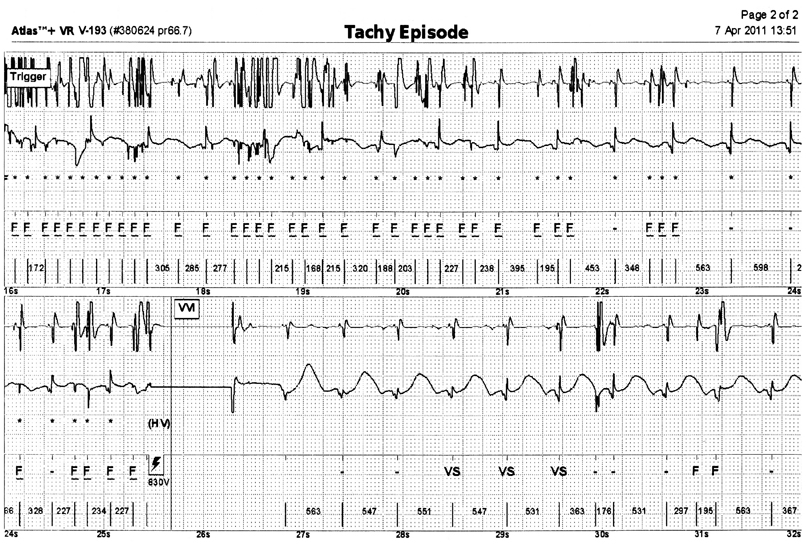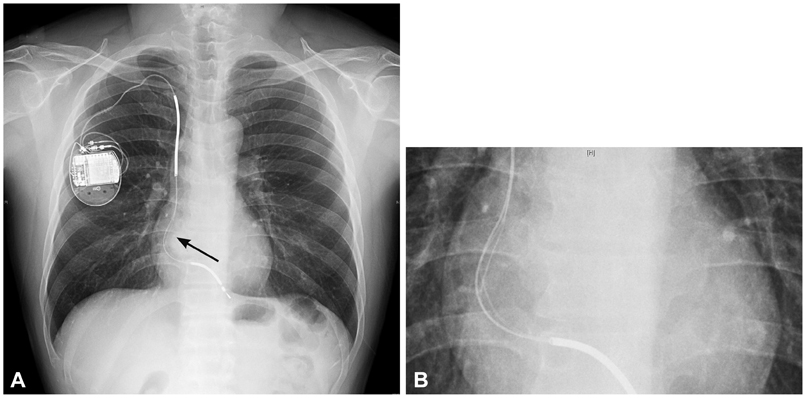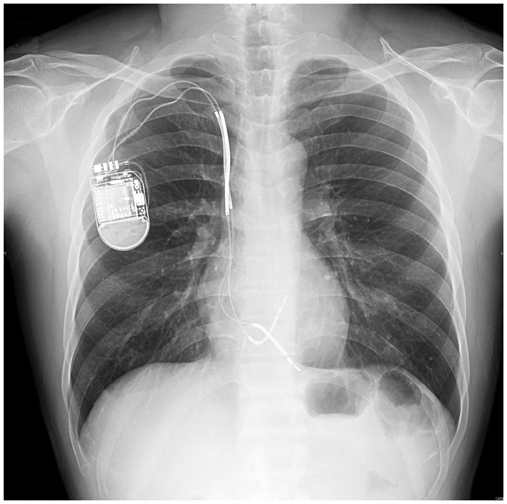Korean Circ J.
2013 May;43(5):336-339. 10.4070/kcj.2013.43.5.336.
A Case of Riata(R) Dual Coil Defibrillator Lead Failure in a Patient with Ventricular Fibrillation
- Affiliations
-
- 1Department of Internal Medicine, Samsung Medical Center, Sungkyunkwan University School of Medicine, Seoul, Korea.
- 2Division of Cardiology, Department of Internal Medicine, Cardiac and Vascular Center, Samsung Medical Center, Sungkyunkwan University School of Medicine, Seoul, Korea. juneskim@skku.edu
- KMID: 2224929
- DOI: http://doi.org/10.4070/kcj.2013.43.5.336
Abstract
- A 50-year-old man, who underwent a procedure for an implantable cardioverter defibrillator (ICD), visited the outpatient department of our clinic after suffering multiple ICD shocks. The ICD interrogation revealed recurrent shock due to a high frequency of noise that is sensed by the device as ventricular fibrillation. Chest radiography revealed a significant split in the insulation of the lead allowing the inner wire to protrude. We considered the removal of the failed lead, but the removal of ICD lead is potentially a high risk procedure, so we cut and capped a proximal part of the failed lead and inserted a new lead. This is the first report of a St. Jude Riata(R) dual coil defibrillator lead failure with clinical and radiologic evidence of a defect in lead insulation in Korea.
MeSH Terms
Figure
Reference
-
1. Zipes DP, Wellens HJ. Sudden cardiac death. Circulation. 1998; 98:2334–2351.2. The Antiarrhythmics versus Implantable Defibrillators (AVID) Investigators. A comparison of antiarrhythmic-drug therapy with implantable defibrillators in patients resuscitated from near-fatal ventricular arrhythmias. N Engl J Med. 1997; 337:1576–1583.3. Gregoratos G, Abrams J, Epstein AE, et al. ACC/AHA/NASPE 2002 Guideline Update for Implantation of Cardiac Pacemakers and Antiarrhythmia Devices--summary article: a report of the American College of Cardiology/American Heart Association Task Force on Practice Guidelines (ACC/AHA/NASPE Committee to Update the 1998 Pacemaker Guidelines). J Am Coll Cardiol. 2002; 40:1703–1719.4. Shen S, Bhave P, Giedrimas E, et al. Prevalence and predictors of cable extrusion and loss of electrical integrity with the Riata defibrillator lead. J Cardiovasc Electrophysiol. 2012; 23:1207–1212.5. Sung RK, Massie BM, Varosy PD, et al. Long-term electrical survival analysis of Riata and Riata ST silicone leads: National Veterans Affairs experience. Heart Rhythm. 2012; 9:1954–1961.6. Valk S, Luijten R, Jordaens L. Insulation damage in a shock wire: an unexpected fluoroscopic image. Pacing Clin Electrophysiol. 2010; 33:770–772.7. Chan CW, Chiang CS. An ICD lead with failure of outer insulation goes undetected by regular measurements. Pacing Clin Electrophysiol. 2012; 35:e261–e262.8. Erkapic D, Duray GZ, Bauernfeind T, De Rosa S, Hohnloser SH. Insulation defects of thin high-voltage ICD leads: an underestimated problem? J Cardiovasc Electrophysiol. 2011; 22:1018–1022.9. Krebsbach A, Alhumaid F, Henrikson CA, Calkins H, Berger RD, Cheng A. Premature failure of a Riata defibrillator lead without impedance change or inappropriate sensing: a case report and review of the literature. J Cardiovasc Electrophysiol. 2011; 22:1070–1072.10. Kodoth V, Cromie N, Lau E, McEneaney D, Wilson C, Roberts MJ. Riata lead failure; a report from Northern Ireland Riata lead screening programme. Eur Heart J. 2011; 32:1838. Abstract.11. Schmutz M, Delacrétaz E, Schwick N, et al. Prevalence of asymptomatic and electrically undetectable intracardiac inside-out abrasion in silicon-coated Riata® and Riata® ST implantable cardioverter-defibrillator leads. Int J Cardiol. 2012; [Epub ahead of print].12. Liu J, Rattan R, Adelstein E, et al. Fluoroscopic screening of asymptomatic patients implanted with the recalled Riata lead family. Circ Arrhythm Electrophysiol. 2012; 5:809–814.
- Full Text Links
- Actions
-
Cited
- CITED
-
- Close
- Share
- Similar articles
-
- The Incidence of Riata Defibrillator Lead Failure: a Single-Center Experience
- Where is the Lead? Inappropriate Implantable Cardioverter-Defibrillator Shock Caused by Extreme Twiddling
- Ventricular Fibrillation in a Patient with Tachycardia-Induced Cardiomyopathy after Liver Transplantation
- Implantable Cardioverter-Defibrillator Lead Extraction by Conventional Traction and Counter-Traction Technique
- An Anesthetic Experience for Automatic Implantable Cardioverter Defibrillator Implantation: A case report





